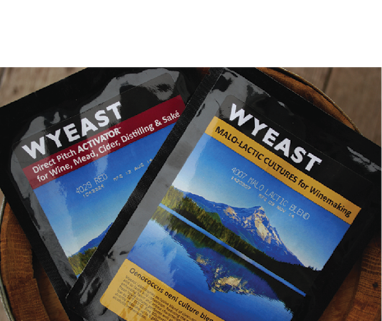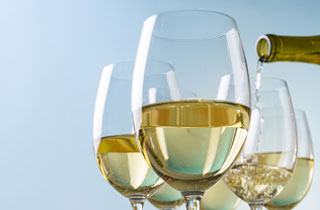 Whether the arguments are based on scientific facts, one’s personal experience, or wisdom, a discussion on the various inoculation practices can certainly polarize winemakers, be it yeast–yeast co-inoculation or yeast–bacteria co-inoculation. There are no straight answers to the pros and cons. For every winemaker — or microbiologist for that matter — who recommends against the practice, along comes another with often only anecdotal evidence to disprove naysayers.
Whether the arguments are based on scientific facts, one’s personal experience, or wisdom, a discussion on the various inoculation practices can certainly polarize winemakers, be it yeast–yeast co-inoculation or yeast–bacteria co-inoculation. There are no straight answers to the pros and cons. For every winemaker — or microbiologist for that matter — who recommends against the practice, along comes another with often only anecdotal evidence to disprove naysayers.
So what is a home winemaker to do? Rely on indigenous yeast for alcoholic fermentation? Concurrently use two (or more) strains of Saccharomyces cerevisiae yeast? Initiate the malo (malolactic fermentation, MLF) midway through the alcoholic fermentation (AF), or perhaps at the end of the AF?
These are just some of the many head-scratching questions being asked by winemakers and researchers. Getting straight answers is complicated by the difficulty, if not quasi impossibility, of measuring results quantitatively. And since the results deal to a large extent with organoleptic qualities, preferences among tasters will inevitable vary.
I for one rely on research and scientific data to validate winemaking theories, but I must admit that I also have anecdotal evidence that refutes the data.
But co-inoculation may have different meanings to winemakers. So let’s first review what is meant by co-inoculation — and the differences with sequential inoculation — and examine some of the scientific hypotheses, facts, and opinions to understand the dynamics at the microbiological and chemical levels. Then you can form your own opinions and join in on the discussions.
Co-inoculation of yeast strains
In what was alluded to earlier as yeast–yeast co-inoculation, this type of co-inoculation may refer to the simultaneous addition of two (and conceivably more) strains of cultured wine yeasts to conduct the AF, or to conducting a sequential addition (what is known as sequential yeast inoculation) using cultured wine yeasts. These practices are usually performed by first suppressing indigenous yeasts using some small amount of sulfite. In traditional winemaking, indigenous yeasts are used for the complete AF, while in modern winemaking indigenous yeasts are suppressed in favor of using cultured yeast for more predictable results.
Co-inoculation could also refer to inoculation using cultured wine yeast following the start of AF by indigenous yeasts, but this is seldom practiced and therefore will not be discussed here.
The idea here would be to take advantage of specific characteristics of the different yeast strains, whether the strains are within the same genus or from a different one. For example, if a strain is known to favor production of fruity aromas and another strain to add spicy flavors, then the results would logically be additive when using both strains. This argument on aroma development extends to compounds that also impact taste and mouthfeel, such as acids and mannoproteins, and other metabolic characteristics, such as producing low levels of sulfur dioxide (SO2), volatile acidity (VA), hydrogen sulfide (H2S), or having the ability to tolerate higher levels of alcohol.
And so, it is not uncommon to find home winemakers who inoculate with two strains of S. cerevisiae. But does it really work? Maybe, maybe not.
Microbiologists will warn against the risks of stuck or sluggish fermentations, off-aromas and flavors, and other unexpected consequences as some yeast will inherently not be compatible as some express membrane proteins known collectively as “killer factor,” whereby a killer factor expressing yeast (e.g. Lalvin EC-1118) can halt the growth of non-killer factor strains. Always check the yeast manufacturer’s specifications and instructions on use.
Sequential yeast inoculation
Sequential yeast inoculation is a much more interesting practice. It involves inoculating the must with a non-Saccha-romyces yeast that is known to contribute positive characteristics to wine but which can only ferment to lower levels of alcohol. The wine is then inoculated with S. cerevisiae yeast to complete fermentation.
Of the non-Saccharomyces yeasts, Torulaspora delbrueckii has been the focus of much recent research as it was determined that it can contribute many positive organoleptic qualities. It was originally thought to belong to the Sacchar-omyces genus and it was named S. rosei, but it has been reclassified — it is still part of the same family and subfamily as Saccharomyces yeasts.
T. delbrueckii (its anamorph is Candida colliculosa) is indigenous to grape microflora in the vineyard and is translocated to the must. It produces less ethanol than S. cerevisiae but considerably more than other non-Saccharomyces yeasts — up to 12% ABV. It has similar SO2 tolerance as S. cerevisiae but it is cryophilic (resists colder temperatures), osmotolerant (tolerates greater pressure from higher sugar content) and produces less VA, making it suitable for high-sugar fermentations, and produces less glycerol, acetaldehyde, H2S, diacetyl and acetoin, and little or no volatile phenols — all compounds that can impart off-aromas and flavors — while contributing positive aromas and flavors.
Certainly T. delbrueckii has many positive attributes that are desirable in winemaking, but it is not suitable on its own; however, when coupled with S. cerevisiae, it has been shown to be highly compatible and that wine greatly benefits. One study has demonstrated that wines fermented with cultured T. delbrueckii yeast followed by a selected, compatible S. cerevisiae yeast strain showed improved aroma profiles with fewer negative side effects, in particular, reduced volatile phenols. S. cerevisiae is added when the specific gravity/Brix is within a range prescribed by the yeast manufacturer.
Another study reports that wines fermented by a similar sequential yeast inoculation showed fruitier aromas with more complexity. The wines had higher levels of fruity ethyl esters and significantly higher levels of 2-phenylethanol. Ethyl esters are compounds present in wines in very low concentrations but which have very low detection thresholds, making them powerful odorants. 2-phenylethanol can contribute aromas of roses, jasmine, lilacs, honey, and spices.
A Scott Laboratories report states that trials of Lallemand’s Level2TD commercial preparation, which combines strains T. delbrueckii 291 and S. cerevisiae 734, showed a VA reduction of more than 50% in late harvest and ice wine production.
T. delbrueckii and S. cerevisiae both depend on the availability of oxygen for synthesizing sterols and phospholipids, key compounds required in yeast metabolism, which can be added exogenously if in short supply. However, T. delbrueckii has a greater dependency on oxygen for cell growth, and is therefore inhibited under anaerobic conditions during fermentation.
Co-inoculation for AF and MLF
Yeast–bacteria co-inoculation is better defined though the hypotheses here too are still undergoing extensive research. This type of co-inoculation is all about timing; it refers to the addition of lactic acid bacteria (LAB) for initiating the MLF. Since the practice involves two types of fermentations, it is also referred to as co-fermentation. Here we are concerned with what is the most opportune time to add the bacteria to minimize any potential inhibition from the increasing ethanol level during AF while maximizing aroma and flavor development.
MLF can be initiated at one of several stages of winemaking: Prior to initiating the AF, concurrently with the AF in what is true co-inoculation, following completion of the AF in what is sequential inoculation, or by letting nature take its course and wait for MLF to restart in the spring following harvest when cellar temperatures start rising again.
The decision on MLF timing is based on wine chemistry, the ability to control environmental parameters (e.g. temperature, oxygen uptake), the influence of these on style (aromas, flavors and mouthfeel), which is dictated by variable levels of diacetyl and other by-products, and the type of LAB selected as these metabolize sugars differently and which can therefore change MLF dynamics. Diacetyl imparts a characteristic butter aroma found in many Chardonnay wines having been processed for MLF.
One important concern is that co-fermenting for both AF and MLF may result in LAB diverting sugar away from yeast and producing high levels of acetic acid, lactic acid and possibly diacetyl, particularly if LAB have completed their organic acid degradation. Another concern is that nutrient-hungry LAB will compete for nutrients with yeast and possibly cause either fermentation to become sluggish or stuck. And if the AF becomes stuck for reasons unrelated to MLF, LAB can continue converting malic acid and then start feeding on sugar and cause undesirable results.
There is still much ongoing research trying to elucidate these behaviors and interactions. There is ample anecdotal evidence claiming that the impacts are minimal or significant, and everything in between.
But to those who are not able to fully control environmental parameters or want to minimize risks of microbial spoilage by sulfiting as soon as both fermentations are complete, the reduced AF-to-MLF duration in co-fermentation is the driving factor. In spite of the concerns above, some winemakers claim that co-fermented MLF is faster and more efficient since LAB are progressively adapting to the changing wine environment and are not subjected to high alcohol as in post-AF inoculation.
Tough decisions
Co-inoculation and sequential yeast inoculation techniques are certainly interesting for winemakers keen on experimenting and testing the unknown. In spite of the vast research, there are still so many variables — not to mention so many different combinations and permutations of applying the techniques — that results can be just that — variable and quite unpredictable. But this is where the art of winemaking precedes the science and makes this hobby so fun and rewarding.







